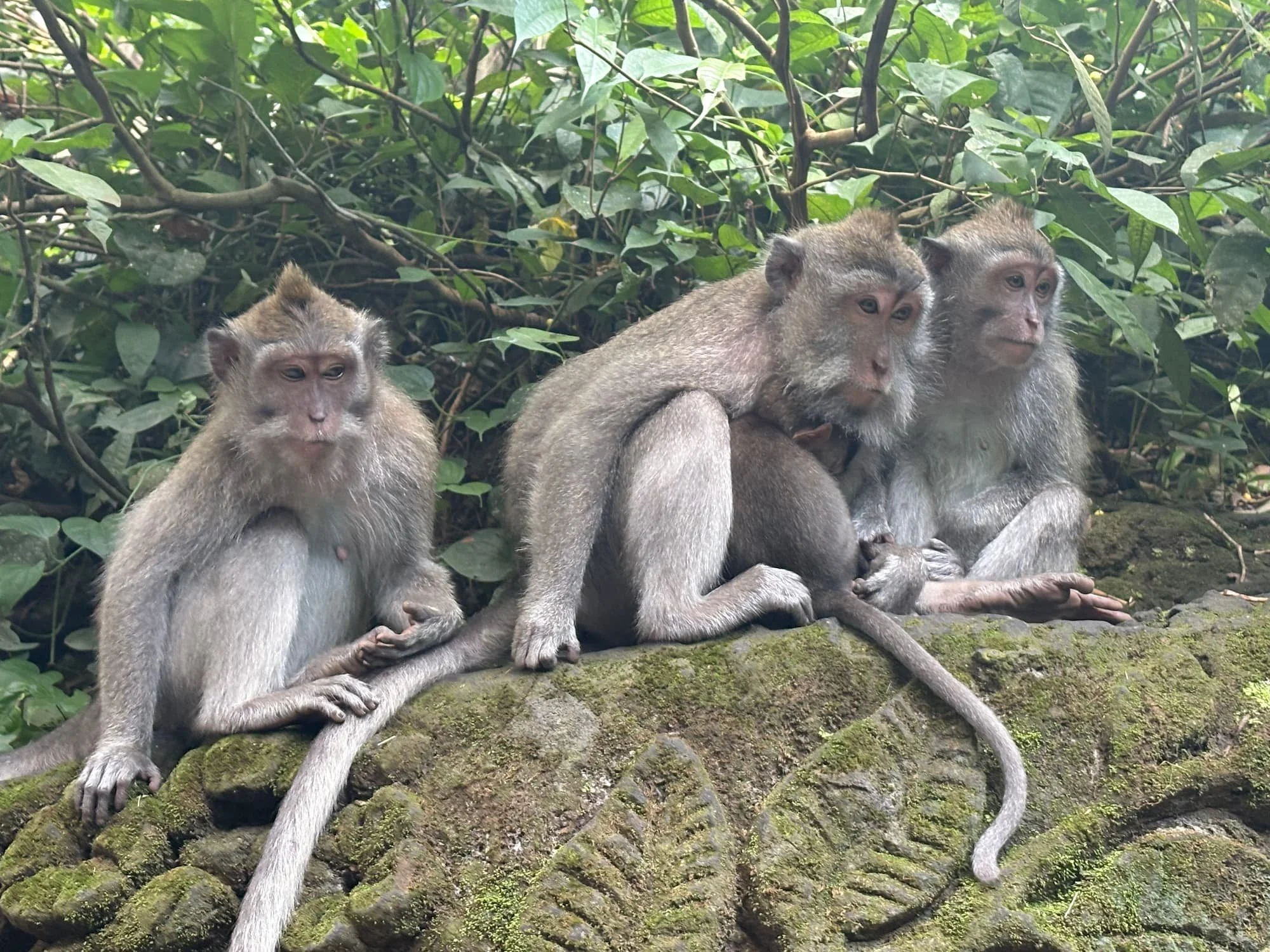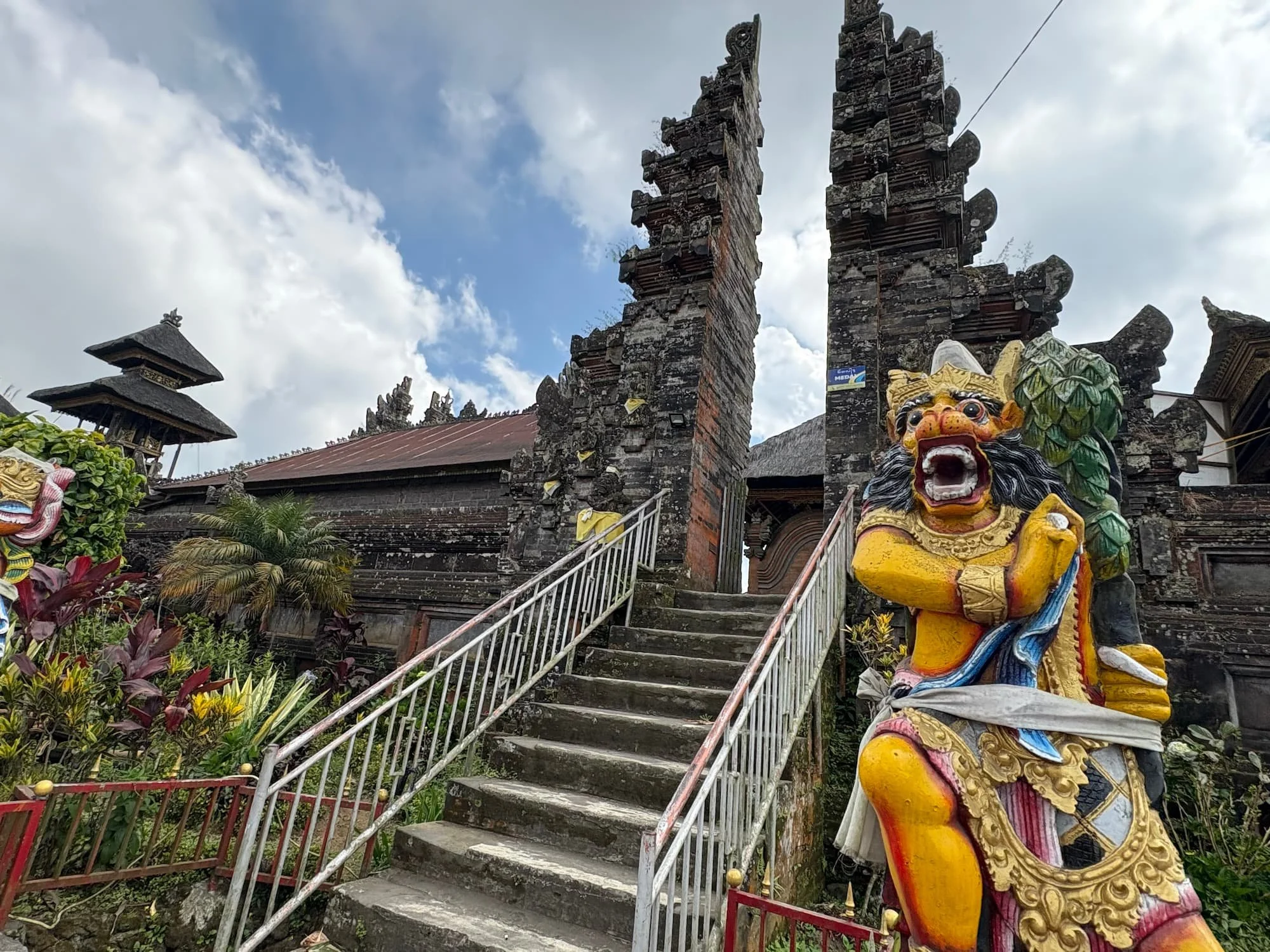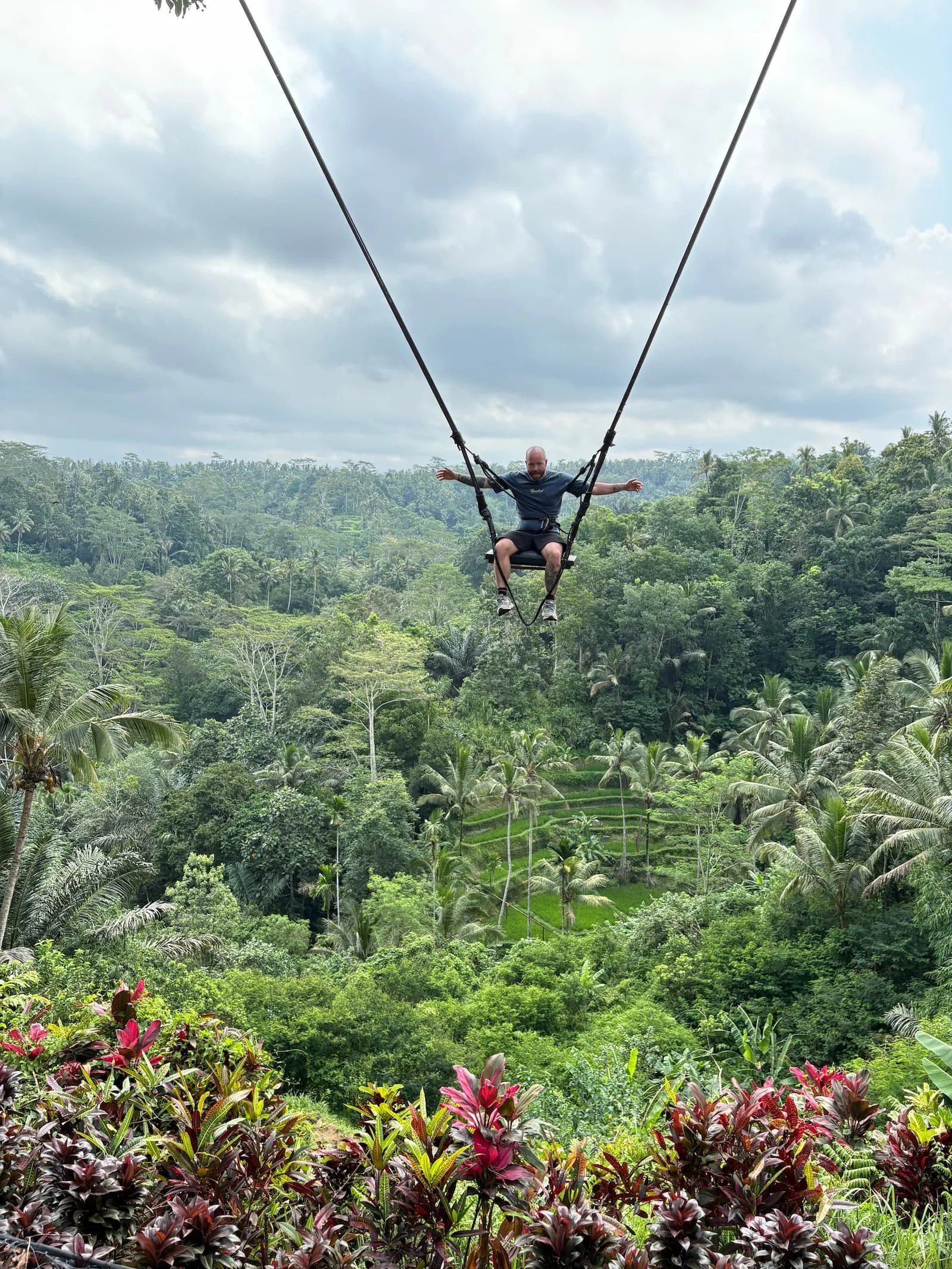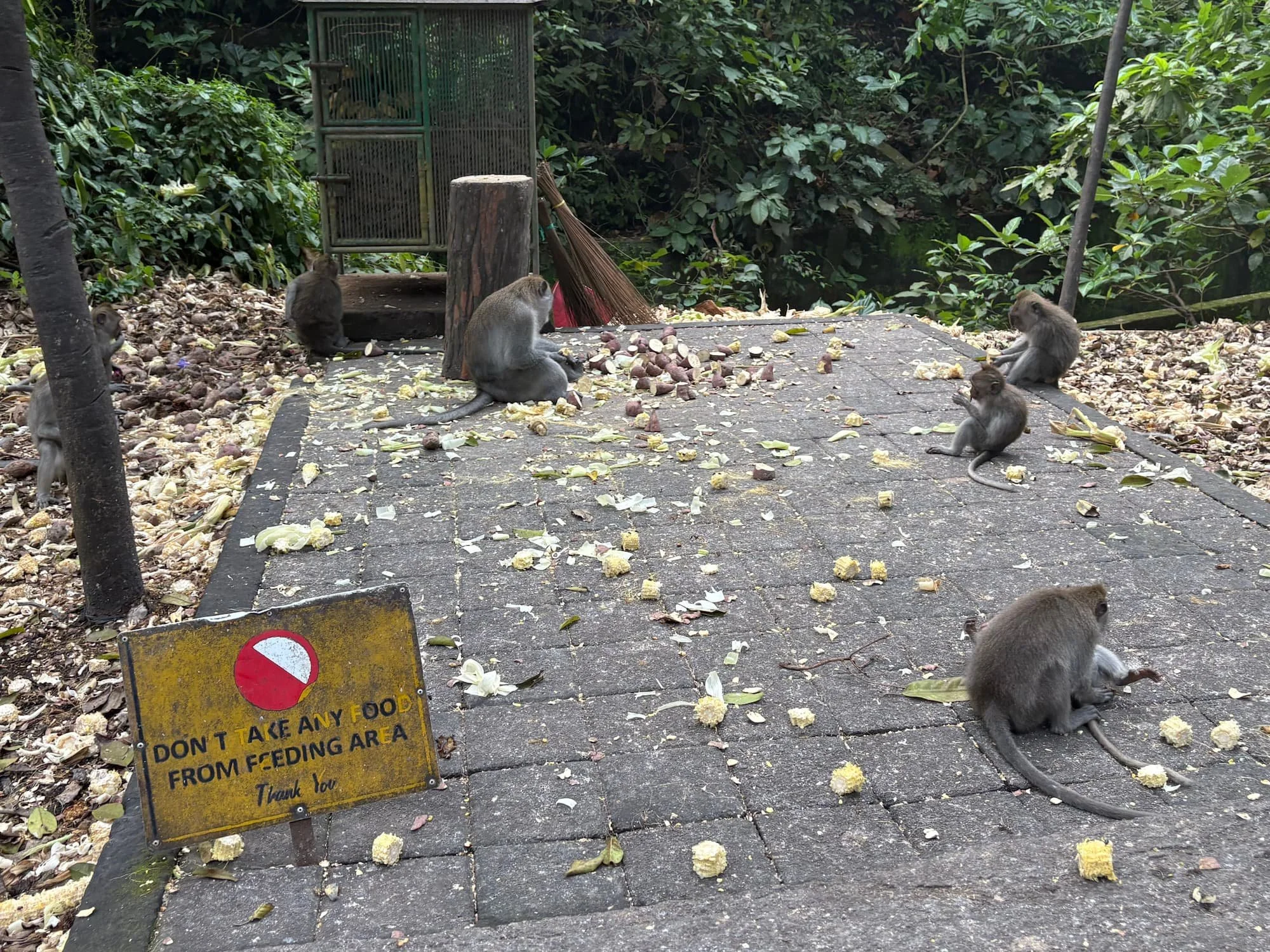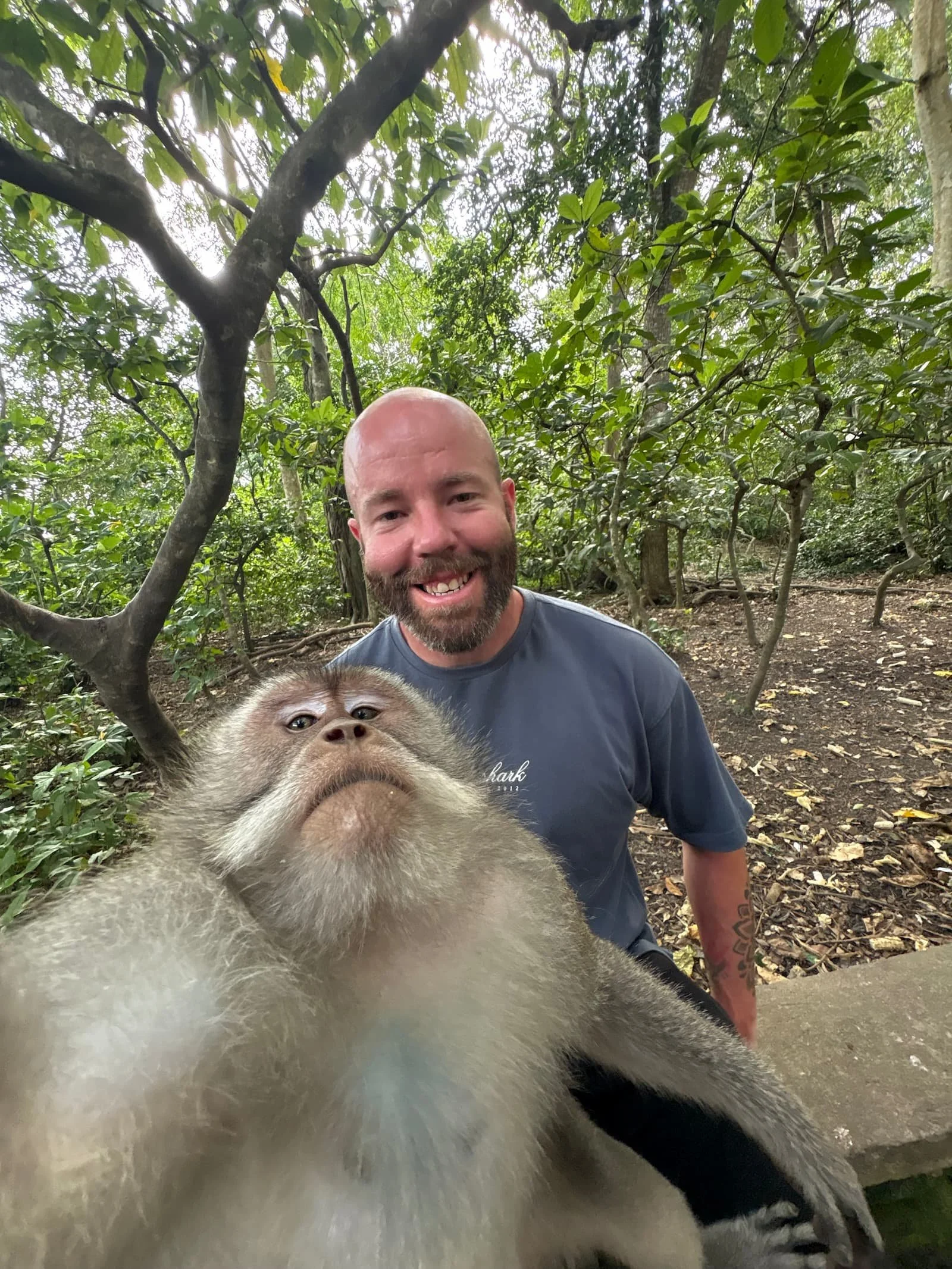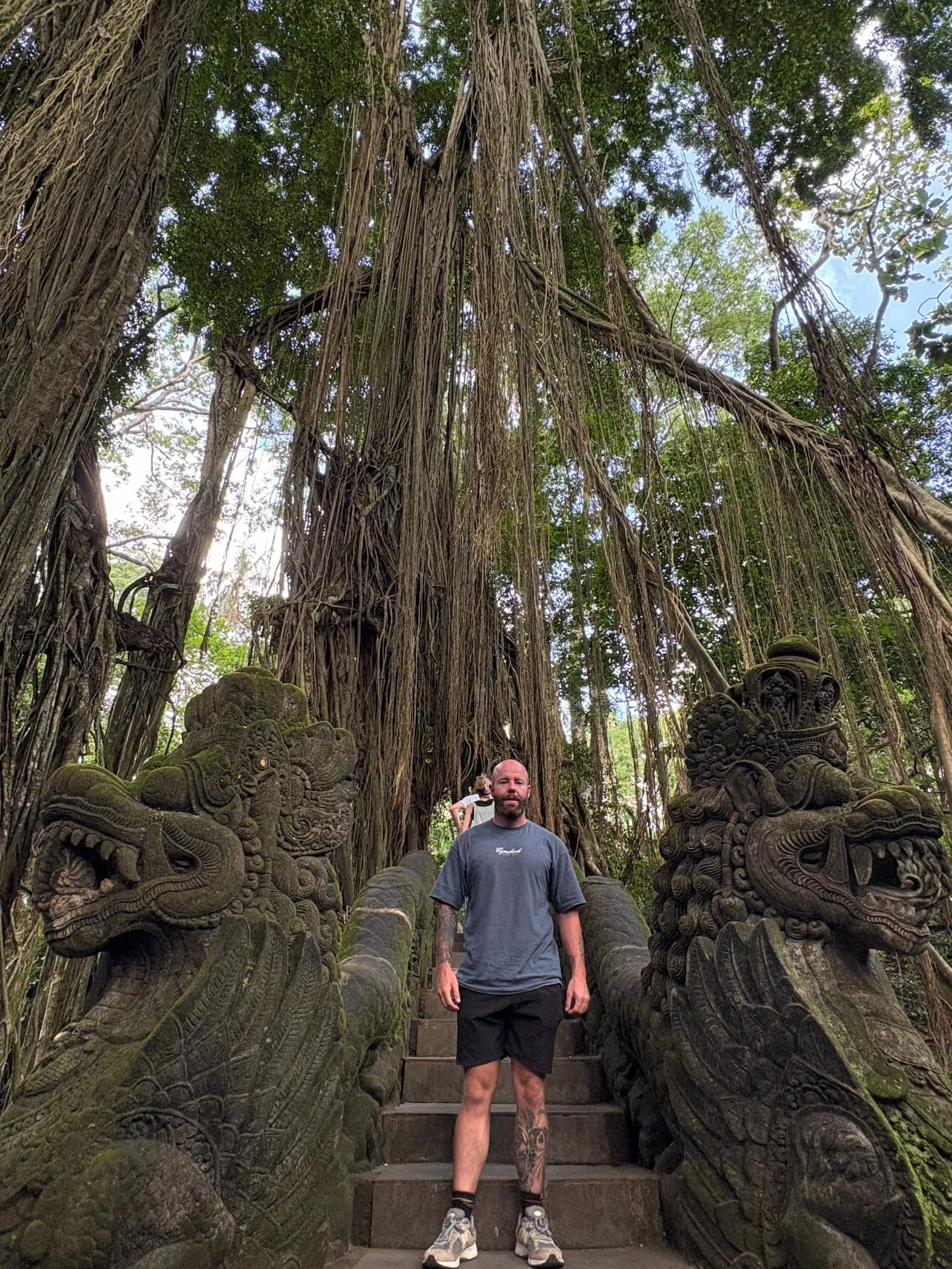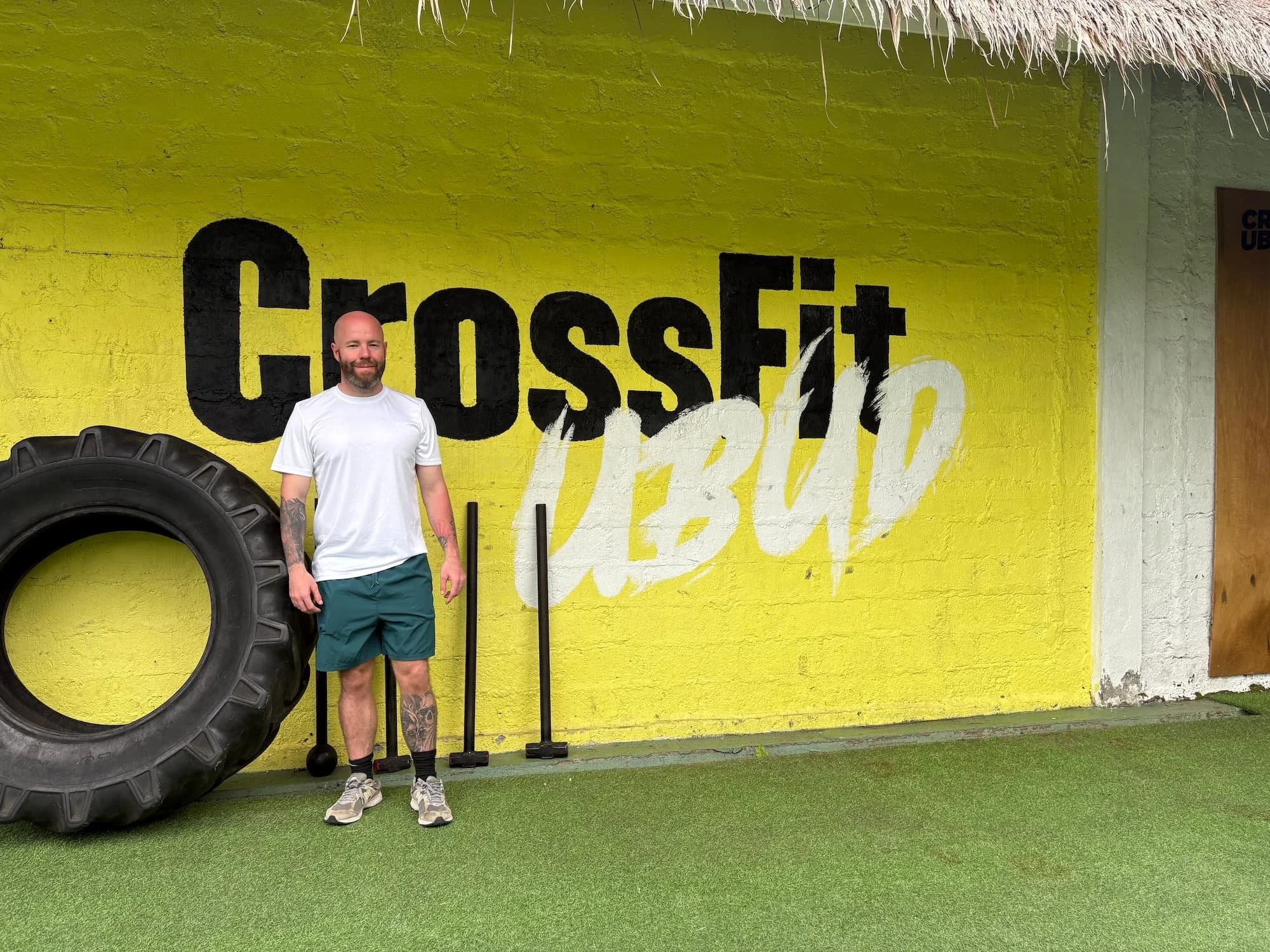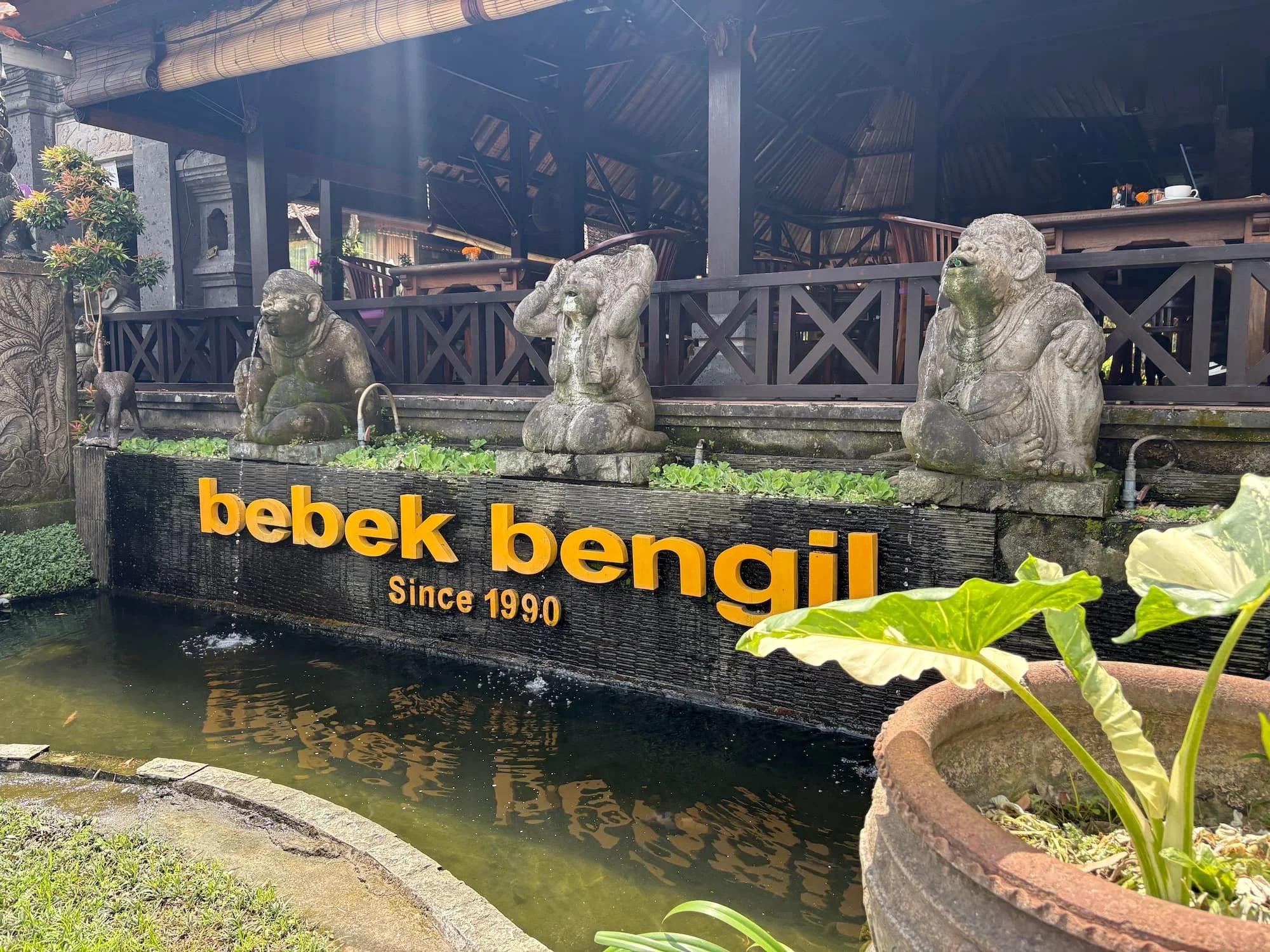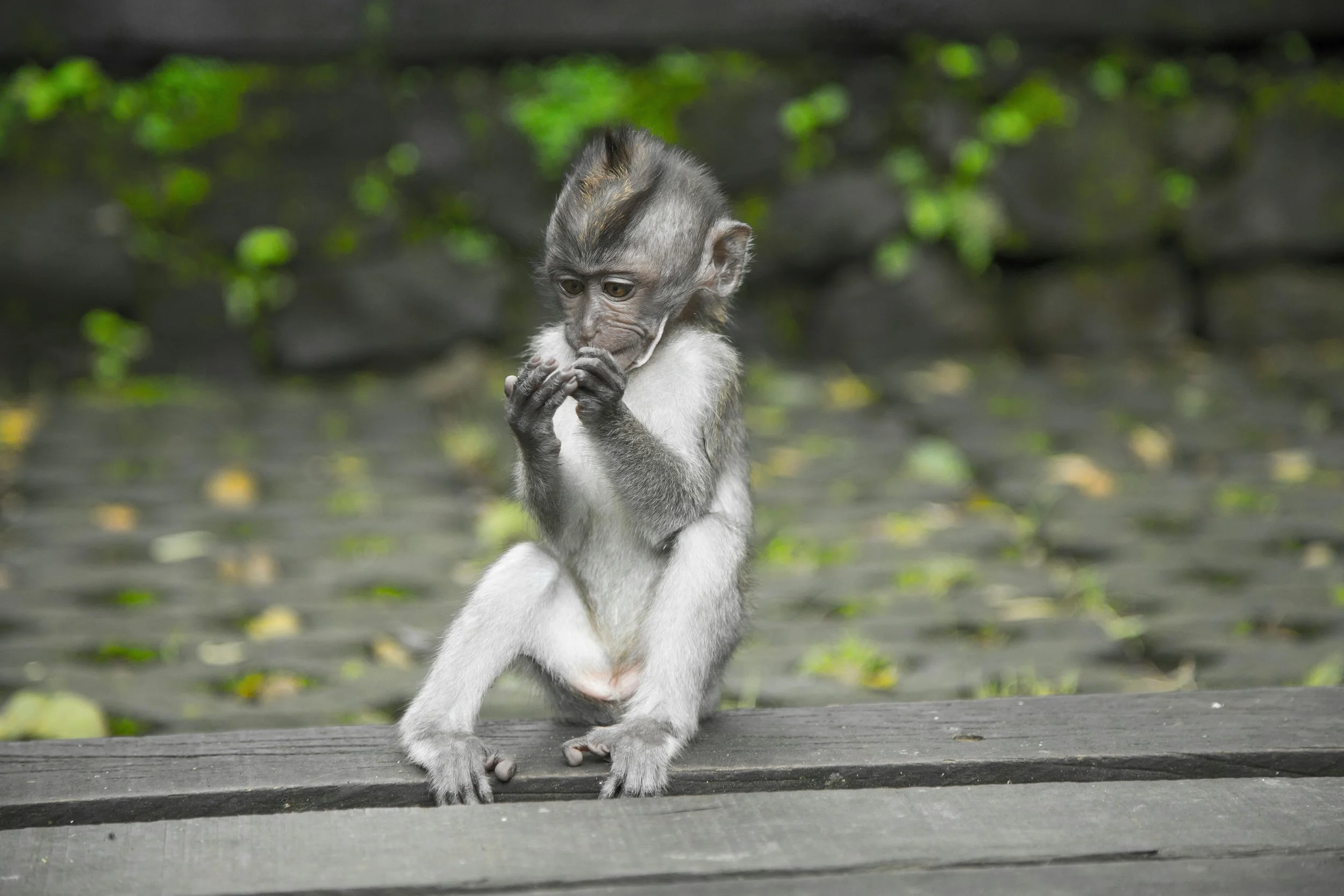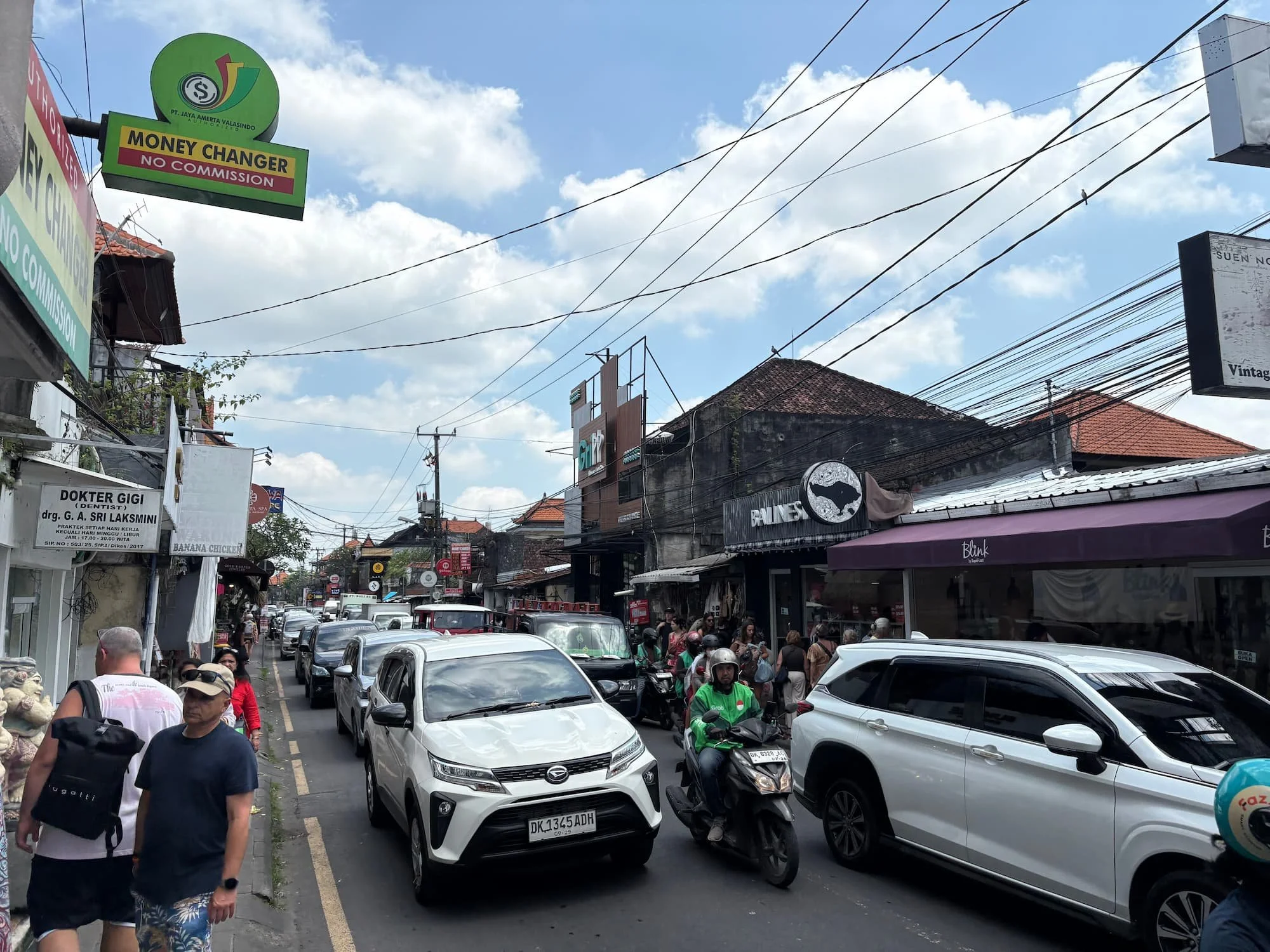What to do in Ubud in Bali for first time visitors.
Monkey selfies… Waterfall hikes… And the most beautiful nature…
Ubud is the perfect introduction to Bali!
Known as Bali’s cultural heart, Ubud blends jungle beauty and tradition… Think rice terraces, hidden temples, and the unmistakable scent of incense drifting through the air.
If you’re planning your first trip to Bali and wondering what to do in Ubud, you’ve come to the right place….
From sunrise ridge walks and temple rituals to spa days and jungle cafés, this guide shows you how to experience the very best of Ubud… Without the overwhelm.
I had some incredible days exploring the Sacred Monkey Forest, Ubud Palace, and the most Instagram-worthy waterfalls.
Then there are the iconic restaurants that blend seamlessly with nature to create an authentic Balinese dining experience.
Ubud isn’t just another stop on the map, it’s where Bali’s spirit comes alive…
Whether you’re here for culture, adventure, or calm, this guide will help you uncover the island’s true soul, one temple, terrace, and waterfall at a time.
Disclosure: I sometimes use affiliate marketing. This will not cost you anything, but helps with my travel costs. I only recommend companies I use myself.
🌿 Rice Fields, Wellness & Jungle Serenity — 3 Beautiful Hotels in Ubud for First-Time Visitors 👇
If you’re visiting Ubud for the first time, stay close to the town centre for easy access to temples, yoga studios, and restaurants , but with jungle views and that signature Bali calm all around you:
Alaya Resort Ubud ⭐⭐⭐⭐ – A tropical sanctuary beside Monkey Forest, combining modern Balinese design with rice field views and world-class spa treatments — my number one pick.
Komaneka at Rasa Sayang ⭐⭐⭐⭐ – A boutique hotel right on Monkey Forest Road, offering serene rooms with private terraces just steps from Ubud’s best cafés and shops.
The Sankara Resort by Pramana ⭐⭐⭐⭐ – Set among coconut palms and rice paddies, this tranquil resort offers infinity pools, traditional charm, and pure relaxation just minutes from central Ubud.
Immerse yourself in Balinese culture.
Without a doubt, if Bali had a soul, it would live in Ubud.
This small inland town has long been known as the cultural heart of Bali for decades…
A place where art, dance, spirituality, and daily life flow together perfectly.
As with everywhere else on the island, canang sari offerings of flowers and rice are laid on the Ubud doorsteps each day.
Every day I wandered through Ubud, I was reminded of how deeply Balinese Hindu traditions shape everyday life here.
Other things that I always remember about the spiritual town after several visits are the strong smells of incense, and colourful shrines.
Ubud’s culture isn’t something created for tourists, it’s lived by the locals every single day.
Ubud feels timeless…
Watching generations of families continue ancient rituals and graceful Legong dances reminded me how much this town has preserved its unique character, even as it’s grown into one of Bali’s most popular destinations.
A typical setting in Ubud.
Ubud Palace & Saraswati Temple.
At the very centre of town stands Ubud Palace (Puri Saren Agung), once home to the royal family and still a gathering place for traditional dance and ceremony.
Its golden gates, intricate carvings, and leafy courtyards give a glimpse into Bali’s regal heritage, and the best part is, it’s free to visit.
Be warned though, there always seems to be very hectic traffic queueing around the palace, which can be a little overwhelming after a while. It certainly ruined the vibe of serenity the day I last visited.
I recommend that you go in the early evening when the Balinese Legong Dance performance begins, as the traffic should have quieted down by then… Not every day, but some days!
Just a few steps away sits the elegant Saraswati Temple, dedicated to the goddess of wisdom and art.
The lotus pond and stone walkway leading to the temple are among the most photographed spots in Ubud, especially at sunset when the light glows gold across the water.
👉 Make Sure You Book Bali: Ubud Palace Legong Dance Show Ticket in Advance Here.
The show sells out most days in peak season…. Arrive just before dusk for the best photos and grab a drink afterwards at Café Lotus, which overlooks the temple.
A beautiful setting.
Tirta Empul Temple.
Let me recommend another temple which is very interesting to visit.
About 30 minutes north of central Ubud lies Tirta Empul, one of Bali’s most sacred temples, where locals and visitors go to take part in a holy water purification ritual, stepping beneath each spring to cleanse the body and mind.
Built around a natural spring in the 10th century, the temple’s clear pools are believed to have healing powers…
Don’t worry, sarongs are provided at the entrance, and if you take a guide, they will explain the significance of each fountain. Our guide ‘Adi’ gave us an awesome day out, and an experience at Tirta Empul, which felt very authentic and spiritual.
For travellers seeking authentic cultural experiences in Bali, Tirta Empul is a must-see!
Visit early in the morning to avoid crowds, and bring a change of clothes if you plan to bathe.
Entrance fee: around IDR 50,000 (£2.50).
Best time to visit: 7–9 am before tour groups arrive.
A Hindu offering (Canang sari) in Ubud.
Goa Gajah (Elephant Cave).
Just ten minutes southeast of Ubud you’ll find Goa Gajah, or the Elephant Cave, an ancient archaeological site dating back to the 11th century.
This was one of my favourite spots in Ubud!
Its dramatic entrance, carved in the shape of a demon’s mouth, opens into a meditation cave once used by Hindu and Buddhist monks.
Outside, moss-covered stone shrines, bathing pools, and trickling fountains stick to Ubud’s Hindu theme.
It doesn’t take long to explore…
I think I was in and out in under an hour, but the history dates back centuries, and is very interesting.
Combine a visit to Goa Gajah with nearby Tegenungan Waterfall for an easy half-day adventure from Ubud.
Entrance fee: IDR 50,000 (£2.50).
Dress code: modest clothing or a provided sarong.
Goa Gajah.
🌸 Experience the Real Ubud with a Cultural Day Tour.
If you want to soak up all of this heritage in a single day, without worrying about transport, timings, or dress codes, you should strongly consider joining a guided Ubud Cultural Tour.
You’ll visit the Sacred Monkey Forest, Ubud Palace, Tirta Empul, and Goa Gajah with a knowledgeable local guide who explains each temple’s stories and rituals.
It’s the most efficient and insightful way to experience the traditions that make Ubud so special…
Adi made our day special, and was an awesome photographer for us all!
👉 Book the top-rated Ubud Temples & Culture Tour on Get Your Guide. It includes hotel pickup, entrance fees, and an expert local guide who brings Bali’s spiritual heart to life.
A picturesque setting on our cultural tour.
Walk the Tegalalang Rice Terraces.
No trip to Ubud is complete without visiting the Tegalalang Rice Terraces, arguably the most famous rice fields in Bali…
Just a 20-minute drive north of central Ubud, these emerald-green terraces carve beautifully into the hillside, creating one of the most photographed landscapes on the island.
I found the views to be incredible, with layers of palm trees, coconut groves, and mirror-like paddies stretching out in every direction.
It was one of my favourite spots on my recent South East Asia trip… And was very similar to Sapa, where I visited on my Vietnam itinerary.
What makes Tegalalang so special isn’t just the scenery, but the atmosphere… Adi told us on our way that it has a very local feel to it, and he wasn’t wrong.
We saw local farmers working the land, which gave us a glimpse of real rural Bali.
Adi teaching us about the local way of life.
The famous Bali swings.
Of course, Tegalalang is also home to the iconic Bali Swings, those dramatic jungle swings that soar above the terraces, which we have all seen on Instagram.
They’re dotted around the valley and range from small local setups to full photo parks with heart-shaped nests and dress rentals.
Prices start around IDR 150,000–250,000 (£8–£13). Go early (8–9 am) for the best light and to avoid waiting in too big of a line…
I found it fun, so I recommend it!
How to visit:
Distance from Ubud: 10 km (under 20 minutes by car or scooter).
Entrance fee: IDR 20,000 (£1).
Parking: Available at the top of the terraces.
Best time to visit: Early morning or late afternoon for softer light and cooler air.
I found the best views from the middle level, where I could stand among the palm trees and see the whole valley.
👉 Book your Tegalalang Rice Terrace & Swing Tour – includes transport, entrance fees, and a local guide who knows all the best photo spots.
So fun!
Amazing scenery.
🐒 Meet Ubud’s most mischievous Locals — The Sacred Monkey Forest.
If there’s one attraction I could recommend that perfectly sums up Ubud’s wild and playful side, it’s the Sacred Monkey Forest Sanctuary…
It is one of my favourite places in Bali.
Before visiting I had seen a few monkeys in the streets of town, exploring, and keeping watch over the tourists, but as soon as I entered the forest I saw hundreds!
Located right in the heart of town, this lush jungle park is home to more than 1,200 long-tailed macaques… And yes, it does feel like this many, they are everywhere!
All living freely among ancient temples, mossy stone carvings, and towering banyan trees.
It’s not just a tourist attraction, but a sacred site deeply rooted in Balinese Hindu philosophy, symbolising harmony between humans, nature, and the spiritual world.
As I wandered through the forest, monkeys leapt from vines above, cheekily tugging at bags and posing (uninvited) for selfies. One even climbed onto my shoulder mid-photo… A classic travel moment.
What makes the Monkey Forest famous?
The forest is divided into three temple complexes, Pura Dalem Agung Padangtegal, Holy Spring Temple, and Prajapati Temple, all beautifully surrounded by lush forest paths and bridges.
Adi was telling us that the main temple dates back to the 14th century, making the sanctuary both a spiritual and historical landmark.
As I wandered slowly, and took my time to explore the stone sculptures covered in green moss, I spotted whole monkey families grooming each other or jumping across vines above my head.
It can get crazy in that forest!
A vast forest full of monkeys.
🌳 Park Layout & Practical Info.
The sanctuary covers about 12.5 hectares, with shaded trails, temples, and even a scenic bridge that cuts through the heart of the forest.
Plan at least 60–90 minutes to explore.
🕘 Opening hours: 8:30 am – 6:00 pm daily.
💰 Entrance fee: around IDR 80,000 (£4).
📍 Location: Monkey Forest Street, central Ubud.
🎫 Booking Your Tickets: Get Your Monkey Forest Ticket here.
💡 Tip: Visit between 8–10 am for the best light and fewer crowds.
Monkey Selfies & Safety Tips.
Getting a ‘monkey selfie’ is practically a rite of passage in Ubud, and a very fun end to the day, but there are a few things to keep in mind:
✓ Don’t bring food — they can smell snacks a mile away.
✓ Keep hold of sunglasses, phones, and bottles.
✓ Never make direct eye contact or show your teeth (they see it as a challenge).
✓ Stay calm if one jumps on you — it’s usually just curiosity!
Despite their mischief, I found the macaques to be fascinating to watch, and park staff do a great job ensuring safety for both visitors and animals.
Book Tickets in Advance.
The entrance line can be long during high season, so it’s worth securing your ticket ahead of time.
👉 Book your Sacred Monkey Forest entry ticket here — includes skip-the-line access, free cancellation, and optional add-ons like hotel pickup or a local guide.
A fun selfie.
A famous banyan tree.
Sangeh Monkey Forest – The quieter alternative.
If you want to experience Bali’s monkeys in a more peaceful setting, head 30 minutes north of Ubud to Sangeh Monkey Forest, which I heard referred to as ’Ubud’s quieter cousin’.
Here, the atmosphere is definitely calmer, the monkeys are friendlier, and the forest feels far more untouched, way less touristy!
The sanctuary sits inside a 6-hectare nutmeg forest, and is still home to around 700 long-tailed macaques, so don’t worry, you are going to see plenty of monkeys!
During my trip to Sangeh Forest, the monkeys were just spending their days lazing in the trees and grooming one another in the shade mainly…
Less running and playing, and definitely less mischief!
And unlike the busy streets near Ubud’s main forest, Sangeh is tranquil… I was often the only visitor on the path, surrounded by tall nutmeg trees that stretch almost 40 metres high.
At the heart of the sanctuary lies Pura Bukit Sari, an 11th-century temple still used for ceremonies by local villagers.
🐒 Why visit Sangeh Monkey Forest?
Smaller crowds and more relaxed atmosphere.
More respectful monkeys (less likely to snatch your belongings).
Scenic nutmeg forest and photogenic temple ruins.
Ideal for photography and quiet observation.
A local resident of Sangeh Forest.
📍 Location: Sangeh Village, approx. 30–40 minutes north of Ubud
🕘 Opening hours: 8:00 am – 5:00 pm.
💰 Entrance fee: IDR 50,000 (~£2.50).
🚗 Getting there: Best reached by scooter or private driver. Combine with Taman Ayun Temple for a cultural half-day trip.
Arriving at Sangeh Forest.
Chase Ubud’s iconic waterfalls.
There is something special about standing beneath a waterfall in the middle of the jungle…
And this is the perfect place to do so… Waterfalls are a big draw to Bali for many international tourists.
Ubud is surrounded by some of the best waterfalls in Bali, each with its own personality, from powerful cascades and cliffside cafés to peaceful jungle pools hidden deep in the forest.
What I love most is that getting to these waterfalls feels like an adventure in itself.
The hikes often wind through rice terraces, bamboo forests, and narrow jungle paths.
Whether you’re chasing the perfect photo, cooling off after exploring temples, or just immersing yourself in Bali’s lush landscapes, visiting Ubud’s waterfalls is an experience that should be on your Bali itinerary.
Tegenungan Waterfall.
Tegenungan Waterfall.
The most famous and easiest to reach, Tegenungan Waterfall is just a 20-minute drive from central Ubud.
Its powerful flow and scenic platforms make it a must for first-time visitors.
We had a really fun swim in the ice cold water, and got some great photos.
📍 Location: Tegenungan Village, Gianyar.
💰 Entrance: IDR 20,000 (£1).
🕘 Best time: Early morning for soft light and fewer visitors.
Tibumana Waterfall.
Tucked deeper into the jungle, Tibumana Waterfall offers a more peaceful and spiritual escape.
The path leading down passes through lush palms and small shrines, before opening up to an enclosed pool framed by sheer rock walls — it feels like discovering a hidden temple.
This spot is perfect for swimming, cooling off, and soaking in Bali’s tranquil side.
📍 Location: Apuan Village, Bangli Regency.
💰 Entrance: IDR 20,000 (£1).
🕘 Best time: 8–10 am or late afternoon for calm and shade.
Kanto Lampo Waterfall.
A favourite among photographers, Kanto Lampo Waterfall is pure drama.
Water cascades over sculpted rocks in thin white streams, creating perfect photo opportunities , and yes, you can climb onto the rocks for that iconic shot.
It’s not as tall as Tegenungan, but the layered rock formations and light filtering through the trees make it one of Bali’s most Instagram-worthy spots.
📍 Location: Beng Village, Gianyar.
💰 Entrance: IDR 20,000 (£1).
🕘 Best time: Late morning when sunlight hits the water directly.
A dreamy setting at Tibumana Waterfall.
Tap into Ubud’s Wellness Scene.
If there’s one thing that defines Ubud beyond its temples and rice terraces, it’s the wellness culture…
As with places like Canggu, or Uluwatu, there’s a real emphasis on feeling good, and slowing down, nourishing your body, and reconnecting with nature.
From sunrise yoga to jungle spas, and CrossFit gyms in nature, Ubud has become a global hub for health, healing, and balance.
After a morning class or massage, you can wander through artisan markets filled with handmade jewellery, woven bags, and essential oils made by local craftspeople.
Then stop for lunch in one of Ubud’s many ‘Jungle Book' cafés’, open-air spaces surrounded by tropical greenery, serving smoothie bowls, cold-pressed juices, and organic Balinese food.
It’s a lifestyle that feels as creative as it is calming, where wellness meets art, design, and culture in every detail.
A Jungle Book Cafe.
Yoga & Healing.
Ubud’s yoga scene is world-famous, attracting everyone from beginners to advanced practitioners, therefore, there are studios scattered across town.
Tropical gardens and open air spaces are the most popular, offering everything from vinyasa and hatha to sound healing and breathwork.
The most iconic spot is The Yoga Barn, a peaceful oasis with multiple studios, a raw café, and holistic therapies like reiki, chakra balancing, and Ayurvedic healing.
If you prefer a quieter setting, Radiantly Alive and Ubud Yoga Centre are fantastic alternatives.
Many studios offer drop-in classes from IDR 150,000 (£7–8), which is perfect for travellers who want to join last-minute sessions.
Spas & Massages.
After a long day exploring rice terraces and temples, nothing beats a traditional Balinese massage…
Ubud is packed with day spas, jungle retreats, and luxury wellness resorts, each blending nature and calm perfectly.
Tourist favourites include Tjampuhan Spa, built into a river gorge with stone-carved therapy rooms, and Karsa Spa, surrounded by rice fields north of town, oth combine ancient Balinese techniques with a stunning natural backdrop.
Expect to pay around IDR 200–400k (£10–20) for a 60–90 minute massage… I found it to be incredible value for such serene settings.
👉 Reserve your Balinese Massage or Spa Experience in Ubud ahead of time — they often sell out during high season.
Fitness Scene.
Ubud might be known for yoga and meditation, but it also has a growing fitness scene for travellers who like to stay active.
CrossFit Ubud (located just south of the centre) offers strength and conditioning sessions in an open-air box overlooking the jungle.
It’s a welcoming community of locals and travellers, and an awesome coach...
You expect group WODs, personal coaching, and a friendly, no-ego vibe. Drop-ins are available daily, and classes start around IDR 200k (£10).
There are also several other gyms and Muay Thai studios around town, ideal if you want to balance Bali’s indulgent side with a good sweat session.
The gyms here are big on sustainability, so bring a refillable water bottle — most gyms provide filtered water stations.
My daily dose of fun fitness.
Eat, drink & relax in Ubud’s jungle cafés.
Dining in Ubud is more than just a meal, it’s a sensory experience…
I had some amazing meals with my girlfriend, as we enjoyed her birthday in the perfect way…
Beautiful food.. And beautiful views!
The vast rice terraces and giant coconut trees fill the jungle valleys, creating the perfect backdrop for some amazing local food.
Whether you’re sipping coffee above the Tegalalang Rice Terraces, or sharing a romantic dinner surrounded by nature, Ubud’s cafés and restaurants blend local flavour with pure tranquillity.
🌴 Tis Café – Coffee, Pools & Rice Terrace Views.
Perched directly above the Tegalalang Rice Terraces, Tis Café is one of Ubud’s most Instagram-worthy spots — and rightly so.
A big draw to Bali are the iconic rice terraces, and Tis Cafe has a sublime view of them.
The infinity pool overlooks cascading rice fields, while coconut palms frame the view in every direction.
It’s the perfect place for brunch after visiting the terraces, with smoothie bowls, Indonesian dishes, and espresso made from locally roasted beans.
Location: Tegalalang Rice Terraces - Best for: Brunch & coffee with a view.
Our amazing views at Tis Cafe.
🌿 Tebasari Resto – Dining among the rice fields.
Set in a lush jungle valley just outside Ubud, Tebasari Resto offers one of the most beautiful dining settings, and my favourite in Bali.
Floating gazebos sit above koi ponds, surrounded by tropical greenery, which is the perfect mix of romance and tranquillity.
I had an amazing time here with my girlfriend.
The food focuses on modern Balinese and Indonesian flavours, with dishes like grilled fish in banana leaves and spicy chicken satay. I stuck to Mie Goreng as I love it so much!
I loved the small details, like the carved bamboo decor, the open-air breeze, the picturesque coconut trees, and the sound of insects echoing through the valley.
Tebasari Resto has an amazing setting.
You should book a table in one of the private floating huts for a special meal.
The privacy, nature, and beautiful dinner created a very romantic experience for my partner and I, and it was one of the best travel moments ever!
Location: Lodtunduh, 10 min from central Ubud - Best for: Romantic dining surrounded by nature.
The private floating huts that my girlfriend and I enjoyed.
Bebek Bengil – The Famous ‘Dirty Duck Diner’.
No Ubud food guide is complete without mentioning Bebek Bengil, literally ‘Dirty Duck’…
This long-running restaurant has become iconic for its crispy fried duck, served with steamed rice, sambal, and vegetables.
Set in a peaceful garden just behind Monkey Forest Road, it’s a wonderful mix of local tradition and relaxed luxury.
The famous duck is marinated for hours in Balinese spice, so it truly lives up to the legend.
This restaurant has so many tables, stretching out into a giant garden with private booths etc… The evening that I visited there was heavy rain for the whole time I was dining. This added to my cosy experience.
Location: Central Ubud, near Monkey Forest - Best for: Authentic Balinese duck & a classic Ubud experience.
One of Ubud’s most famous restaurants.
Other great spots to try:
Warung Bukit Cinta – a hidden gem with panoramic rice field views east of Ubud. It’s peaceful, affordable, and a favourite among locals for breakfast or sunset drinks.
Clear Café – airy, open-plan design with salads, smoothies, and cold-pressed juices. Great for digital nomads and relaxed lunches.
Sayuri Healing Food – colourful vegan café with raw desserts, smoothie bowls, and a yoga-inspired vibe.
Warung Biah Biah – local favourite for nasi campur and mie goreng at great value. Expect friendly service and authentic flavours.
Warung Pondok Madu – famous for its grilled ribs and home-style Indonesian dishes. A must-try for meat lovers.
Another great spot.
Beautiful local food.
Where to Stay in Ubud (Best Areas & Hotels).
Ubud has accommodation for every style, from boutique jungle villas to cosy homestays in the heart of town.
Choosing the right area makes a big difference to your experience:
🌿 Central Ubud – Best for First Timers.
If it’s your first visit, stay near Ubud Palace or Monkey Forest Road, as you’ll be close to cafés, markets, and temples, and everything is walkable. I found a great homestay in this area on my first trip.
You should expect boutique hotels, yoga studios, and spa retreats tucked behind tropical courtyards.
🛏️ Top pick: Komaneka at Monkey Forest – elegant Balinese design with a peaceful garden pool, right in the centre.
🌾 Rice Field Views – Best for Tranquility.
Just a few minutes north of town, you’ll find hotels and villas overlooking endless rice terraces.
Perfect if you want calm mornings, infinity pools, and jungle sounds instead of traffic.
🛏️ Stay at: Adiwana Svarga Loka – riverside setting, spa, and yoga pavilion surrounded by greenery.
Our amazing bathroom.
Luxury Jungle Retreats – Best for Couples.
For a romantic escape, Ubud’s luxury resorts deliver bucket-list views.
Infinity pools, candlelit dinners, and private villas set deep in the jungle make it pure Bali magic.
🛏️ Favourite: The Kayon Resort – breathtaking cliff-side suites, floating breakfast, and a serene adults-only vibe.
Our awesome private villa.
Another cool spot.
How long do you need in Ubud?
For first-time visitors, I recommend 3–4 days in Ubud.
That gives you enough time to explore temples, rice terraces, waterfalls, and cafés at a relaxed pace, without feeling rushed.
Here’s my quick guide:
1–2 days: Perfect for day-trippers or tight schedules, see Monkey Forest, Ubud Palace, and Tegalalang Rice Terraces.
3–4 days: The sweet spot, add Tirta Empul, a waterfall, a cultural show, and some downtime at a spa or jungle café.
5+ days: Best for yoga, retreats, cooking classes, or day trips to Mount Batur and Tirta Gangga.
I stayed four days and could’ve easily done a week. Ubud rewards slow travel, so the longer you stay, the more hidden gems you find.
👉 Browse Ubud Day Tours & Activities to plan the perfect balance for your trip.
One of Ubud’s cute residents.
Best time to visit Ubud.
Ubud’s tropical climate means it’s warm all year, with two main seasons:
☀️ Dry Season (April–October).
Sunny, low humidity, cooler evenings (27–30°C)
Best for sightseeing, rice terraces, waterfalls & temple visits
Peak months: July–August — book tours early
I have visited Ubud in April and September recently, and the conditions were awesome both times.
🌧 Rainy Season (November–March).
Short daily downpours, humid, lush scenery.
Fewer crowds & cheaper hotels.
Great for photography, wellness, and greenery lovers.
Best choice: May–early July - the perfect balance of sunshine, green rice fields & fewer tourists.
👉 Book a Ubud Temples & Waterfalls Tour timed perfectly for the season.
A monkey mad town.
Getting to Ubud.
Ubud sits in central Balim so it is about 35 km north of Denpasar Airport (Ngurah Rai International Airport), and is around 1.5 hours by car, depending on traffic.
There’s no train or public bus direct from the airport, so you’ll need a transfer, taxi, or private driver.
✈️ From Denpasar Airport (Ngurah Rai).
Private Transfer: Fastest and easiest. Air-conditioned, fixed price.
Cost: around IDR 350–450k (£18–£25).
👉 Pre-book your Most popular Ubud Airport Transfer for a smooth arrival.Taxi: Slightly cheaper if booked on arrival, but expect to haggle.
Ride-Share (Grab/GoJek): Usually available from outside the airport gate; handy for solo travellers.
From other Bali places.
Seminyak / Canggu: 1.5–2 hrs.
Kuta / Jimbaran: 1–1.5 hrs.
Uluwatu: 1–1.5 hrs.
Sanur: 1 hr.
Private drivers are best for day-trip flexibility; scooters are not recommended for long hauls due to traffic and heat.
The traffic is alwasy bad in Ubud.
FAQ’s for visiting Ubud in Bali.
After sharing my favourite things to do in Ubud, let’s tackle some of the most common questions travellers ask before visiting Bali’s cultural heart. Before we dive into the details:
Is Ubud worth visiting in Bali?
Absolutely. Ubud is the cultural and spiritual heart of Bali, filled with temples, waterfalls, rice terraces, and yoga retreats.
It’s quieter and greener than coastal areas like Canggu or Seminyak, making it perfect for first-timers looking to experience the island’s beautiful nature and authentic side.
How many days do you need in Ubud?
I recommend 3 to 4 days to see the main highlights, including temples, rice terraces, Monkey Forest, and waterfalls, at a relaxed pace. If you want to add wellness experiences or day trips like Mount Batur or Tirta Gangga, plan for 5 or 6 days.
What is Ubud best known for?
Ubud is best known for its lush rice terraces, temples, monkeys, yoga culture, art markets, and wellness retreats. It’s Bali’s creative and spiritual centre, surrounded by jungles, waterfalls, and stunning nature. It was a great place for a romantic visit with my girlfriend.
What are the best things to do in Ubud?
The must-dos include visiting Tegalalang Rice Terraces, Sacred Monkey Forest, Tirta Empul Temple, Tegenungan Waterfall, and walking the Campuhan Ridge. Don’t miss a jungle brunch at Tis Café or Tebasari Resto for incredible views.
What’s the best month to visit Ubud?
The dry season (April–October) is the best time to visit for sunny days and clear skies. However, the rainy season (November–March) offers lush landscapes, fewer crowds, and cheaper accommodation, which can be ideal if you don’t mind a few afternoon showers.
Is Ubud safe for tourists?
Yes, Ubud is very safe. Locals are welcoming, crime is low, and solo travellers often feel comfortable here. The only things to watch for are busy roads and cheeky monkeys who love shiny objects, so keep valuables tucked away when visiting the Monkey Forest.
How far is Ubud from the beach?
Ubud is located inland, about 1.5 hours from Canggu or Seminyak depending on traffic. I split my Bali trip, with a few days in Ubud for nature and culture, followed by the beach for sunsets and surfing.
Colourful gardens in a temple in Ubud.
My verdict – Is Ubud worth visiting?
Absolutely. Ubud is 100% worth visiting!
It’s the one place in Bali that captures everything that makes the island special…
Nature, spirituality, culture, and creativity, all wrapped in jungle beauty.
Every day in the jungle town feels unique and fun.
One day I was taking selfies with the local monkeys, the next I was soaking in a holy spring, or sipping ice coffee above endless rice terraces.
I love the fact that it still feels authentically Balinese, even with its popularity.
I still watched locals continue their daily rituals, with offerings filling the streets, as the sound of monkeys playing drifts through the air
Whether you come for a few days or a few weeks, Ubud rewards curiosity, so it is the perfect stop on your travels!
Disclosure: I sometimes use affiliate marketing. This will not cost you anything, but helps with my travel costs. I only recommend companies I use myself.

